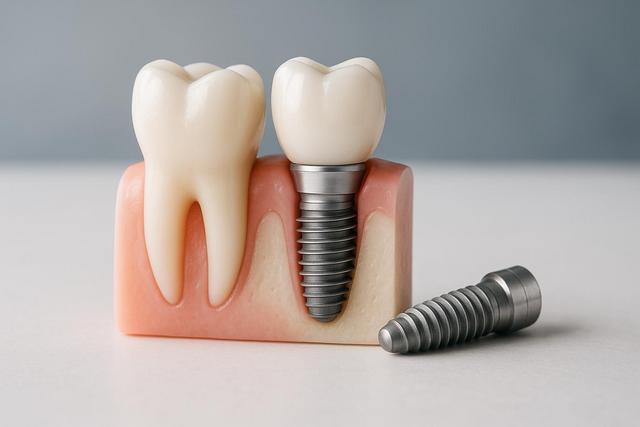
Dental Implants: Benefits, Longevity, and Everyday Care
Outline
Dental Implants: Benefits, Longevity, and Everyday Care—here’s what matters most in one practical, research‑informed guide.
- What dental implants are and who might consider them
- Key benefits you can feel day to day
- Longevity: what high‑quality studies show
- Everyday home care that supports healthy implants
- Professional maintenance and recall cadence
- Risks, warning signs, and how to lower your risk
- Materials: titanium, zirconia, and titanium–zirconium alloys
- Costs, insurance questions, and value considerations
- Step‑by‑step treatment journey and typical timeline
- Comparison: implant vs. bridge vs. removable denture
- FAQs and websources
What are dental implants—and who should consider them?
A dental implant is a small post placed in the jaw to act like an artificial tooth root, supporting a crown, bridge, or denture. For many adults with single‑tooth gaps, several missing teeth, or loose dentures, implants are among the top options because they feel secure and can help you chew and speak with confidence. The American Dental Association explains the basics of implant structure and treatment phases, including surgical placement and restoration [1]. The American Academy of Periodontology outlines related procedures such as sinus augmentation and ridge modification that may be recommended to improve implant stability in areas with limited bone [2].
Commercial implant systems vary in design and features; if you’re researching brands to discuss with your clinician, examples include Straumann’s titanium–zirconium alloy designs [12] and Nobel Biocare’s implant families used in immediate and conventional protocols [13]. Your dentist will help match a system to your clinical needs and goals.
Benefits you can feel day to day
- Stable chewing and speech: Because implants are anchored in bone, many people find the experience closer to natural teeth than removable options, supporting varied diets and clearer speech [1], [2].
- Preservation of adjacent teeth: A single implant‑supported crown typically doesn’t require reshaping neighboring teeth, unlike some fixed bridges [1].
- Comfort and confidence: Fixed restorations avoid the movement some denture wearers experience, which can reduce sore spots and improve confidence in social settings [1], [2].
While implants are highly rated for function and comfort, they still require the same daily care mindset you’d use with natural teeth—brushing, cleaning between teeth, and regular professional check‑ins.
Longevity: what the evidence shows
Large reviews show strong medium‑ to long‑term performance when implants are properly planned and maintained:
- At 5 years, implant survival supporting single crowns is commonly reported around the mid‑90% range, and the implant‑supported crowns themselves also perform well, with some technical complications noted (such as screw loosening and veneer chipping) [3].
- At around 10 years, studies of single implants report implant survival rates generally in the mid‑90% range, while some crowns may need repair or replacement over time due to wear or chipping [4].
These numbers are averages across varied patient types and techniques, so your prognosis will reflect your specific health factors, bone quality, bite forces, hygiene, and follow‑up care.
Everyday care: your at‑home routine
Daily habits make a measurable difference. The ADA recommends brushing twice daily with fluoride toothpaste, cleaning between teeth daily, and routine dental visits to monitor oral health [8]. Around implants, interdental cleaning is important; a randomized trial found interproximal brushes, water flossers, and floss improved plaque control when used consistently around implant‑supported single crowns [9]. Choose low‑abrasive toothpaste and a soft brush to be gentle on implant components, and follow your clinician’s guidance on specialty floss, threaders, or interdental brushes [2], [7], [9].
Pro Tip: If you use a water flosser around an implant crown, trace slowly along the gumline and under the contact points. Then brush with fluoride toothpaste so the fluoride isn’t rinsed away before it has time to work [8], [9].
Professional maintenance and recall
Evidence‑based reviews suggest that structured maintenance supports long‑term success. A scoping review of maintenance protocols recommends regular recalls—often more frequent during the first year—tailored to your risk profile and home‑care effectiveness [7]. Many clinicians use a 3–6 month interval initially, then adjust the cadence based on tissue health, plaque control, and any prosthetic issues [7]. Your team may also take baseline and periodic radiographs to monitor crestal bone levels around the implant [7].
Key goals at these visits include: assessing tissues for bleeding or swelling, checking occlusion, removing biofilm and calculus with instruments appropriate for implant surfaces, evaluating screw stability, and reviewing your home‑care technique [7].
Risks, warning signs, and how to lower your risk
Two inflammatory conditions can affect implants: peri‑implant mucositis (gums inflamed without bone loss) and peri‑implantitis (inflammation with progressive bone loss). A recent systematic review using standardized criteria estimated that roughly one in four implant patients experienced peri‑implantitis, highlighting the importance of prevention and early intervention [5]. A 2025 prospective cohort also linked higher risk to factors such as a history of severe periodontitis, smoking, certain prosthetic designs (e.g., full‑arch fixed), and more complex anterior locations [6].
- Know the early signs: redness, bleeding on brushing, persistent bad taste, or swelling around the implant. Report changes promptly so your clinician can intervene early [5], [6].
- Control modifiable risks: don’t smoke or vape, maintain diabetes control with your physician, and practice meticulous daily cleaning [6], [8].
- If you previously had periodontitis, you may need closer maintenance since historical periodontal disease is a recognized risk indicator [16].
Clinician insight: “Implants succeed long‑term when patients treat them like high‑value teeth—daily care at home plus regular checks to catch small issues early.”
Materials and options: titanium, zirconia, and mixed alloys
Most implants are titanium, a renowned material for strength and biocompatibility. Zirconia (ceramic) implants are an alternative, sometimes chosen for esthetic reasons in select cases. Systematic reviews show similar short‑term survival in limited studies but mixed findings overall; several analyses favor titanium for survival and less marginal bone loss at 12 months, while longer‑term zirconia data remain smaller in scale [10], [11]. Your clinician will weigh tissue biotype, esthetics, bite forces, and available bone when recommending a material.
Examples you may hear about in consults include titanium–zirconium alloy options designed for strength in narrower sites [12] and implant designs positioned for immediate or conventional loading protocols [13]. These are product examples only—your provider will select the system that aligns with your exam, imaging, and goals.
Costs, insurance, and value considerations
In the United States, a single‑tooth implant with abutment and crown commonly totals a few thousand dollars. Consumer healthcare sources report typical ranges of about $3,000–$7,000 per tooth, with variability for imaging, extractions, bone grafting, or sinus lift procedures when needed [14]. Insurance coverage differs by plan; some policies contribute up to a percentage of the surgical and/or restorative phases, subject to annual maximums, while others exclude implants and cover alternatives instead. It’s wise to request pre‑authorization and a written treatment estimate before scheduling [15].
- Ask for a transparent, line‑item plan showing: diagnostic workup, surgery, parts, abutment, crown, and follow‑up care.
- Budget for maintenance: just like a car needs oil changes, implants benefit from professional cleanings and periodic imaging over time [7].
Step‑by‑step: from consultation to crown
While each case is unique, your path may look like this:
| Step | What happens | Approximate timing |
|---|---|---|
| Consultation & imaging | Exam, 3D imaging (CBCT), risk assessment, and discussion of options including non‑implant alternatives. | 1–2 visits |
| Site preparation (if needed) | Extractions, bone grafting, or sinus augmentation to improve stability in low‑bone areas, when appropriate [2]. | Weeks to months for healing |
| Implant placement | Implant is placed in the jawbone; many cases heal for several weeks to months for osseointegration before loading. | Same day surgery; 6–12+ weeks typical healing (varies) |
| Abutment & provisional | Connector (abutment) placed; in some cases, an immediate temporary is used when stability and soft tissues allow. | Same day or later |
| Final restoration | Custom crown, bridge, or overdenture is fitted and adjusted for bite and esthetics. | After soft‑tissue maturation |
| Maintenance | Recall visits for professional cleaning, checks, and periodic imaging based on risk [7]. | Ongoing (often 3–6 months initially) |
Implant vs bridge vs removable denture: a practical comparison
| Feature | Single Implant + Crown | Tooth‑Supported Bridge | Removable Partial/Full Denture |
|---|---|---|---|
| Impact on adjacent teeth | Typically none (no tooth prep) | Adjacent teeth usually reshaped to hold bridge | None |
| Stability while chewing | Fixed; generally very stable | Fixed; stable when well designed | Varies; may move slightly |
| Bone preservation at missing‑tooth site | Helps maintain bone through functional loading | No direct effect at site | No direct effect at site |
| Typical maintenance | Daily brushing + interdental care; periodic professional maintenance | Daily care incl. floss threaders/interdental brushes | Daily cleaning of denture; periodic relines/repairs [17] |
| Longevity (evidence snapshot) | High implant survival at 5–10 yrs; crowns may need repair/replace over time [3], [4] | Good longevity; may need replacement due to wear or decay on abutment teeth | Typically replaced/relined over time; hygiene essential for tissue health [17] |
Everyday tips for success
- Use a soft‑bristle brush and low‑abrasive toothpaste; clean under contacts with floss, threaders, or interdental brushes as directed [2], [7], [9].
- If you clench or grind, discuss a night guard to protect your restoration [7].
- Don’t ignore bleeding or soreness—early checks help avoid larger interventions [5], [6].
- If you have a history of periodontitis, plan on closer maintenance and personalized home‑care coaching [16].
FAQ
Frequently Asked Questions
How long do dental implants last?
With good home care and regular maintenance, implants show high survival for many years. Reviews report survival commonly in the mid‑90% range at 5–10 years, though some crowns need repair or replacement over time [3], [4].
Is the surgery painful?
Most people describe pressure and mild soreness for a few days, manageable with over‑the‑counter medication. Your clinician will discuss anesthesia options and after‑care instructions tailored to your case [2].
How do I clean around the implant?
Brush twice daily with fluoride toothpaste and use interdental tools your dentist recommends (floss, threaders, interdental brush, or a water flosser). Consistent technique matters more than the specific tool, according to a randomized trial [8], [9].
Am I at risk for peri‑implantitis?
Risk rises with factors like past severe periodontitis and smoking. Early professional detection and daily plaque control are key [5], [6], [16].
Are zirconia implants “metal‑free” and do they last longer?
Zirconia is a ceramic and metal‑free option. Current reviews show mixed findings with shorter follow‑ups; several analyses favor titanium for survival and marginal bone levels at 12 months. Discuss pros and cons with your clinician for your specific situation [10], [11].
What do implants cost—and does insurance help?
Typical U.S. ranges for a single implant, abutment, and crown are about $3,000–$7,000, varying by complexity and location. Insurance coverage varies; request pre‑authorization and a written estimate [14], [15].
Websources
- [1] ADA MouthHealthy — Implants
- [2] American Academy of Periodontology — Implant procedures and adjunctive surgeries
- [3] NCBI Bookshelf — 5‑year survival and complications of implant‑supported single crowns
- [4] PubMed — 10‑year survival of single implants (systematic review)
- [5] PubMed — Global prevalence of peri‑implant diseases (systematic review, World Workshop criteria)
- [6] PubMed — Prospective cohort: incidence and risk factors for peri‑implantitis
- [7] PubMed — Scoping review of maintenance protocols for implant‑supported prostheses
- [8] ADA — Official oral health recommendations
- [9] PubMed — RCT: interdental cleaning methods around implant‑supported crowns
- [10] PubMed — Zirconia vs. titanium implants (systematic review and meta‑analysis)
- [11] PubMed — Meta‑analysis: clinical performance of zirconium vs. titanium implants
- [12] Straumann — Roxolid (titanium–zirconium) implant material
- [13] Nobel Biocare — NobelActive implant information (U.S.)
- [14] GoodRx — Typical U.S. implant cost ranges and add‑on factors
- [15] Investopedia — Insurance considerations for dental implants
- [16] ADA — Periodontitis overview and classification
- [17] ADA — Denture care and maintenance (for comparison)


